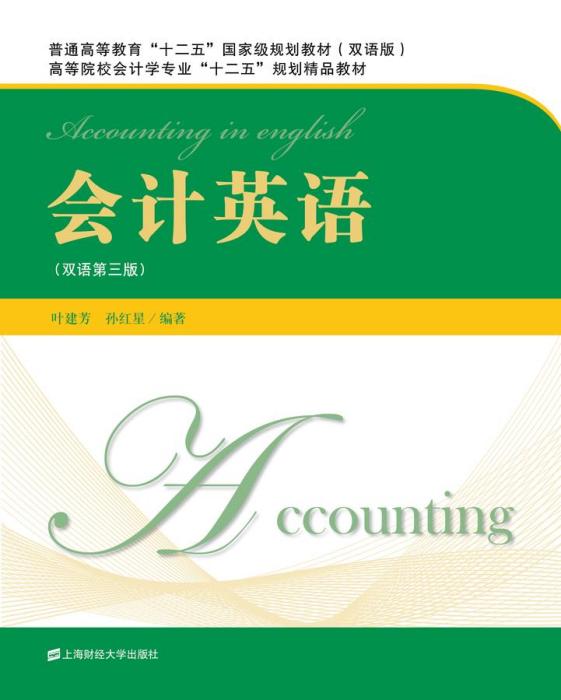《會計英語(雙語第三版)》是2015年6月上海財經大學出版社出版的圖書,作者是葉建芳。
基本介紹
- 書名:會計英語(雙語第三版)
- 作者:葉建芳
- ISBN:9787564221515
- 定價:38元
- 出版社:上海財經大學出版社
- 出版時間:2015年6月
- 開本:16開
內容簡介,圖書目錄,
內容簡介
《會計英語》(雙語第三版)作為“十一五”和“十二五”國家級規劃教材《會計英語》的雙語版,秉承了其特點,結構上分為十章:第一至第三章是對會計的性質以及會計信息產生過程的敘述;第四章是商業企業會計; 第五至第九章是關於資產、負債和所有者權益的確認、計量和報告;第十章是關於有關企業經營活動對現金流量表的影響,以及如何編制現金流量表。
為保持我國企業會計準則與國際財務報告準則的持續趨同,進一步完善我國企業會計準則體系,提高財務報表列報質量和會計信息透明度,2014年伊始,財政部發布了3個新的準則和修訂了5項具體會計準則。本書針對新的準則以及變化, 第三版的相應內容做了一些修訂,修訂的內容主要涉及投資業務(第七章第二節)。
圖書目錄
1 An Introduction to Accounting 1
1.1 Accounting is an Information System 2
1.2 Forms of Organization 2
1.3 The Framework for the Preparation and Presentation of Financial
Statements 3
1.4 Understanding of Financial Statements 4
· Balance Sheet 5
· Income Statement (Statement of Financial Performance) 5
· Statement of Owner’s Equity 6
· Statement of Cash Flows 8
1.5 Accounting and its Profession 9
1.6 Accounting Elements and Using the Accounting Equation 9
· What is Accounting Equation 9
· Effects of Transactions on the Accounting Equation 10
1.7 Ethics in Accounting 12
·Some Basic Ethical Standards 13
Vocabulary 14
Self-Test Questions 15
Discussion Questions 16
Exercises 16
Problems 18
2 Recording Transactions 22
2.1 Economic Events and Business Documents 23
2.2 T Accounts and Debit & Credit 23
·Types of Accounts 24
·Chart of Accounts and Ledger 26
·The Accounting Equation and the Rules of Debits and Credits 27
·Normal Balances 27
2.3 Journalizing and Posting Transactions 27
·Journalizing Transactions 30
·Posting Transactions 33
2.4 Preparing a Trial Balance 36
·Trial Balance 36
·Locating and Correcting Errors 37
·Formatting Conventions 38
2.5 Using the Information—the Debt Ratio 38
Vocabulary 39
Self-Test Questions 40
Discussion Questions 41
Exercises 41
Problems 42
3 Adjusting the Accounts, Preparing the Statements, and Completing the
Accounting Cycle 46
3.1 The Need for Adjustments 47
·Time Period Principle 47
·Need for Adjustments at the End of an Accounting Period 47
·Accrual and Cash Basis of Accounting 48
3.2 Adjusting the Accounts 49
·Prepaid Expenses 49
·Depreciation 50
·Unearned Revenues 52
·Accrued Expenses 53
·Accrued Revenues 53
3.3 Adjusted Trial Balance and Preparation of Financial Statements 54
3.4 Using the Worksheet 60
·Purpose of the Worksheet 60
·Preparing Worksheets 61
3.5 Closing Entries 62
·Purpose of Closing Entries 63
·Preparing the Closing Entries 63
3.6 Post-closing Trial Balance 65
3.7 Classification of Balance Sheet Items 66
·Assets 66
·Liabilities 67
·Owner’s Equity 67
3.8 Using the Information—the Current Ratio 69
Vocabulary 69
Self-Test Questions 70
Discussion Questions 71
Exercises 72
Problems 73
4 Accounting for Merchandising Enterprises 77
4.1 Service Enterprise versus Merchandising Concern 78
·Service Enterprise 78
·Merchandising Enterprise 78
· Periodic and Perpetual Inventory Systems 78
4.2 Purchase, Sales Revenue and Cost of Goods Sold 79
·Merchandise Purchases—Perpetual Inventory System 79
·Purchase Returns and Allowances 79
·Trade Discounts 79
·Purchase Discounts 80
·Transportation Costs 81
·Revenue from Sales and Cost of Goods Sold—Perpetual Inventory System 83
·Sales Returns and Allowances 83
·Sales Discounts 84
·Shrinkage 85
·Summary of Merchandising Cost Flows 85
4.3 Multiple

